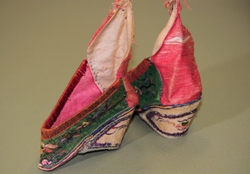Plastic surgery’s no good for the sole
|
In 10th century China, women with tiny feet were considered the epitome of beauty and femininity. Toes were bound tightly so that they curled under the foot, effectively breaking bones and ensuring the toes would permanently stay that way. From age five on, the front and back of women’s feet would be forced together, creating the desired look of dainty feet. Today, women are once again going to great lengths to ensure their feet and legs look beautiful and fit properly into high end shoes and sandals through procedures such as second and third toe-shortening and lobbing off the fifth, or pinky, toe altogether. |
Audiocast Temple Podiatry Professor Tracey Vlahovic discusses how going to extremes in the name of beauty can have harmful effects.
|
|
To a lesser extreme, women are also having surgery to correct crooked toes, remove bunions and inject the pad of the foot with collagen, all to guarantee a perfect fit – both in their heels and in the latest ideal of beauty. “Women are going to extreme measures just to fit into a shoe,” said Tracey Vlahovic, DPM, an associate professor at Temple University’s School of Podiatric Medicine specializing in podiatric dermatology. “In certain cases, it can change the mechanism of the foot for no good reason, and it goes against the principles of foot surgery.” While Vlahovic doesn’t do invasive cosmetic foot treatments, she does provide patients with several all-natural and non-invasive treatments for those who seek beautiful, summer-ready feet and legs: Plant extracts: For more than a year now, Vlahovic has been treating patients with a number of foot maladies with Marigold Therapy, a mixture of the stems, seeds and petals of the marigold plant. There are several formulas, and each has different properties, from clearing up plantar warts to healing athlete’s foot. She also offers pain treatments made of extracts of the pitcher plant and others from a mixture of extracts from flowers like daisies, sunflowers and marigolds. |
 Jeanne Lockner/Temple University
In 10th century China, women tightly bound their feet to fit into the tiny, yet stylish, Lotus shoes (above.) These days, women are once again going to extremes to make their feet fit into stylish shoes, but Temple podiatrist Tracey Vlahovic says there are a number of natural, non-invasive things women can do to make their feet beautiful.
|
Glycolic acid: Glycolic acid is found in sugarcane, sugar beets, pineapple, cantaloupe, and unripe grapes, and is a powerful exfoliant. Vlahovic offers the treatment as a peel to patients looking for soft and smooth legs. Honey: Vlahovic and several of her colleagues offer patients with hard-to-heal wounds a dressing made of honey and seaweed, which cuts healing times considerably. Fake nails: (But not those drugstore types.) Vlahovic crafts these by applying a resin directly to the toe, over existing nails that are damaged by fungus or injury. This allows her patients to get treatment for their nails while not having to worry about their appearance. This new technique, called Keryflex, is an import from Germany. |
|
“These procedures can provide a great looking foot and leg, and don’t cause unnecessary pain to the patient,” she said. “It makes a patient feel better about him or herself, and it doesn’t change the mechanics of the feet and legs.” Vlahovic warns women considering invasive cosmetic foot surgery to consider all the facts before going under the knife. “Many women see surgery as a quick fix, but it’s not,” she said. “It takes a long time to recover, and during that time there is limited mobility, and you have to work your way back into those pointy toed pumps you want to wear. It may mean lengthy sessions of physical therapy and walking with crutches or a cane while recuperating.” Not only is there a lengthy recovery time, the risks of these extreme procedures include tissue breakdown, necrosis, and even a painful scar. Given all this, Vlahovic feels that the benefits don’t outweigh the costs. “You shouldn’t change your whole life just to fit into a shoe.” |
|